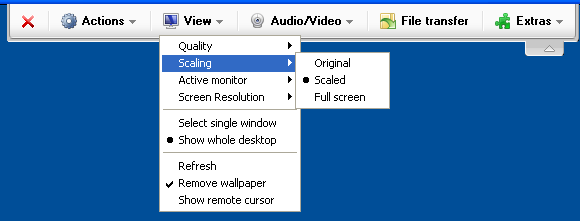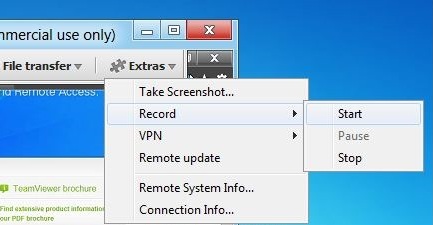Tips to help you use TeamViewer more effectively and smoothly
TeamViewer is a remote control and connection software used by many users thanks to its outstanding features. Users can download and install TeamViewer on Windows, Mac and Linux operating systems. It is a free and easy-to-use application that allows you to connect to any computer or server in seconds.
But sometimes being easy to use doesn't mean you won't have any difficulties. The following article will share tips to help you get a more effective TeamViewer experience.
1. Optimize image quality and speed

If you want to actually use the device you're connecting to like a computer right in front of you, you'll need to adjust the full screen setting. On the TeamViewer toolbar at the top of the head, left-click View > Scaling and select Full Screen mode.
However, it is best if you can combine the screen resolutions of both machines. Otherwise, your remote computer may have 'widescreen' syndrome and create black bars on the top and bottom of the screen or you will experience extremely poor picture quality.
Don't worry about resetting everything, your computer will return to the original settings after you disconnected.
If you experience lag, lag, you can tweak some settings by selecting View in the toolbar of TeamViewer. Then, you move the control button from Highest quality to Highest speed side in the Quality section and select Optimize speed. In this way, although you will sacrifice image quality, the latency will be overcome.
When you return to the Quality menu, you will see some options in Edit Custom Settings such as reducing colors, disabling the Aero color scheme of Windows and disabling GUI illustrations ...
Customize it as you like until you are satisfied with the connection speed achieved. If everything is still too slow, you need to find an Internet connection with better speed.
2. Use your TeamViewer account for quick and easy access
Normally, when you start TeamViewer, you will be given a random ID and password. However, by creating a TeamViewer account, you can easily access your computer anywhere and anytime you want.
On the desktop, launch TeamViewer and look for Connection at the upper left of the window, click it and choose Setup unattended access ... then follow the instructions to set up a new account.
To connect to the device you have set up for easy access, enter Partner ID, then click Connect to partner. Disconnect from the computer and click on the star icon in the same place you just entered the ID number. You now have the option to create a free TeamViewer account. You can save names and passwords for future use.
Among the features of TeamViewer, one outstanding feature is Wake-On-Lan which allows you to remotely wake a computer from sleep or hibernation mode. To enable this feature, your system must meet the following certain criteria:
- Computer is connected to a power source.
- The computer's network card supports Wake-On-Lan feature.
- Computer is connected to the Internet.
- The computer is in one of the following states:
+ Sleep: Start> Sleep
+ Hibernation: Start> Hibernation
+ Shut down (Soft off): Start> Shut down
3. Share files between multiple computers

You can move files from one device to another with TeamViewer. Go to the toolbar of TeamViewer and select File transfer to access the files on the desktop or the File box to drag and drop the files you want to share.
If you use TeamViewer on Windows and connect to an insecure network like a public Wi-Fi network, you can set up a VPN on TeamViewer for additional protection. To do this, you first need to connect to the computer, then select Extras on TeamViewer's toolbar and then click on VPN and Start.
Once you've created the VPN, you can choose File Transfer and share the files as you normally would. The VPN option allows the computer you are using to use the same network as the computer you control. That means you can remotely control devices like printers and print at home or access the drive to retrieve important data.
4. Record what you do

When using TeamViewer, you can record sessions. Once connected, select Extras on the TeamViewer toolbar and click on Record. There you will see three options: Start, Pause and Stop. When you click Start to start recording, you will see the REC icon flickering in the right corner of the screen.
When you stop recording, just select the location where you want to save the file. With the saved audio file, you can play, stop or even convert to another format.
5. Control on mobile devices

In case you need access to a home computer but currently don't have a laptop in front of you, you can connect using your mobile devices.
With the TeamViewer app on mobile devices, you can remotely control devices and even perform file transfers like on a computer.
TeamViewer has a friendly interface, easy to use and offers a variety of useful features for work that are always appreciated by users. With the tips introduced above, hope you can make the most of its features.
Good luck!